Former players becoming managers — it happens all the time! So often, in fact, we barely bat an eyelid when it happens. There is a widely held belief that having spent years playing the sport and gaining invaluable experience, former players have a unique perspective. Those in power at football clubs believe this will bring about the success they are constantly chasing. Pep Guardiola and Carlo Ancelotti are prime examples of legendary players going on to become undeniably exceptional managers. The former is widely acclaimed for developing a style of play that so many young managers aspire to emulate.
The managerial world doesn’t completely consist of former players though, sometimes a manager with no former playing experience at all breaks through and brings about a whole new tactical style. Arrigo Sacchi famously never played football and began his managerial career at 26 after working as a shoe salesman for many years. Plenty of journalists questioned his lack of playing experience, and many didn’t even trust him, but Sacchi’s response to these doubters is still considered legendary to this day:
“A jockey doesn’t have to have been born a horse.”
It’s fair to say, the man has a point.
The subject of this tactical analysis is a manager who, much like Sacchi, has never been a professional footballer. Instead, he began managing amateur football in Portugal and has worked his way up to the Primeira Liga. The man in question is 37-year-old Luís Freire, who is currently gaining many plaudits for his style of play at Rio Ave. After guiding them to promotion last season, the club looks set to consolidate its position as a top-flight club with a comfortable mid-table finish this season.
This tactical analysis will focus on the tactical evolution of Luís Freire, we will take a trip down memory lane to analyse how his tactics have developed over time. We will also look into Freire’s current tactics at Rio Ave and provide an analysis of why the club from Vila do Conde is performing beyond expectations this season.
Who is Luís Freire?
Born in Mafra, Luís Freire began his coaching career whilst at university, after initially coaching local athletes, he began scouting at football clubs Mafra and Tondela. In 2012, he started coaching his local side Ericeirense, after achieving three promotions by 2015, he then took the opportunity to move to Pêro Pinheiro where he gained promotion once again and was beginning to garner attention from the local side Mafra.
Freire achieved promotion with Mafra, guiding them to the Campeonato de Portugal title on the final day of the 2017-2018 season. His remarkable record of five promotions in six years of management earned him the nickname ‘a poor man’s Vitor Oliveira’ after the man who was promoted to the top flight 11 times throughout his managerial career.
After being promoted with Mafra, Freire moved to Estoril in July 2018; they were also in the second division at the time. For the first time, the young manager struggled to make an impact and departed the club in January 2019. His next managerial opportunity came by way of Nacional who had just been relegated to the second tier. Promotion expert Freire soon fixed this and led them back to the top flight. Life in the Primeira Liga was tough for Nacional, Freire left his position as manager in March 2021 as they were dragged into the relegation battle.
A few months later, newly relegated Rio Ave came calling, Freire’s promotion expertise was put to good use once again as under his leadership, the team won the 2021-2022 Liga Portugal 2 title which meant they bounced back as champions.
With an incredible record of seven promotions in 10 years, Freire has made an excellent return to the Primeira Liga. His Rio Ave team were widely tipped to be relegated once again. However, under the 37-year-old’s tutelage, the team have performed above expectations and remain on course to finish the season very securely in mid-table. Let’s now take a look at the tactical evolution of Luís Freire.
The makings of a manager at Mafra
Perhaps the best way to begin this analysis of Luís Freire is to take a brief look back at his time at Mafra. The season spent here was very much a learning curve for Luís Freire, whilst he brought success to Mafra by leading them to promotion, he changed formation quite a lot as if he was searching for his preferred style of play.
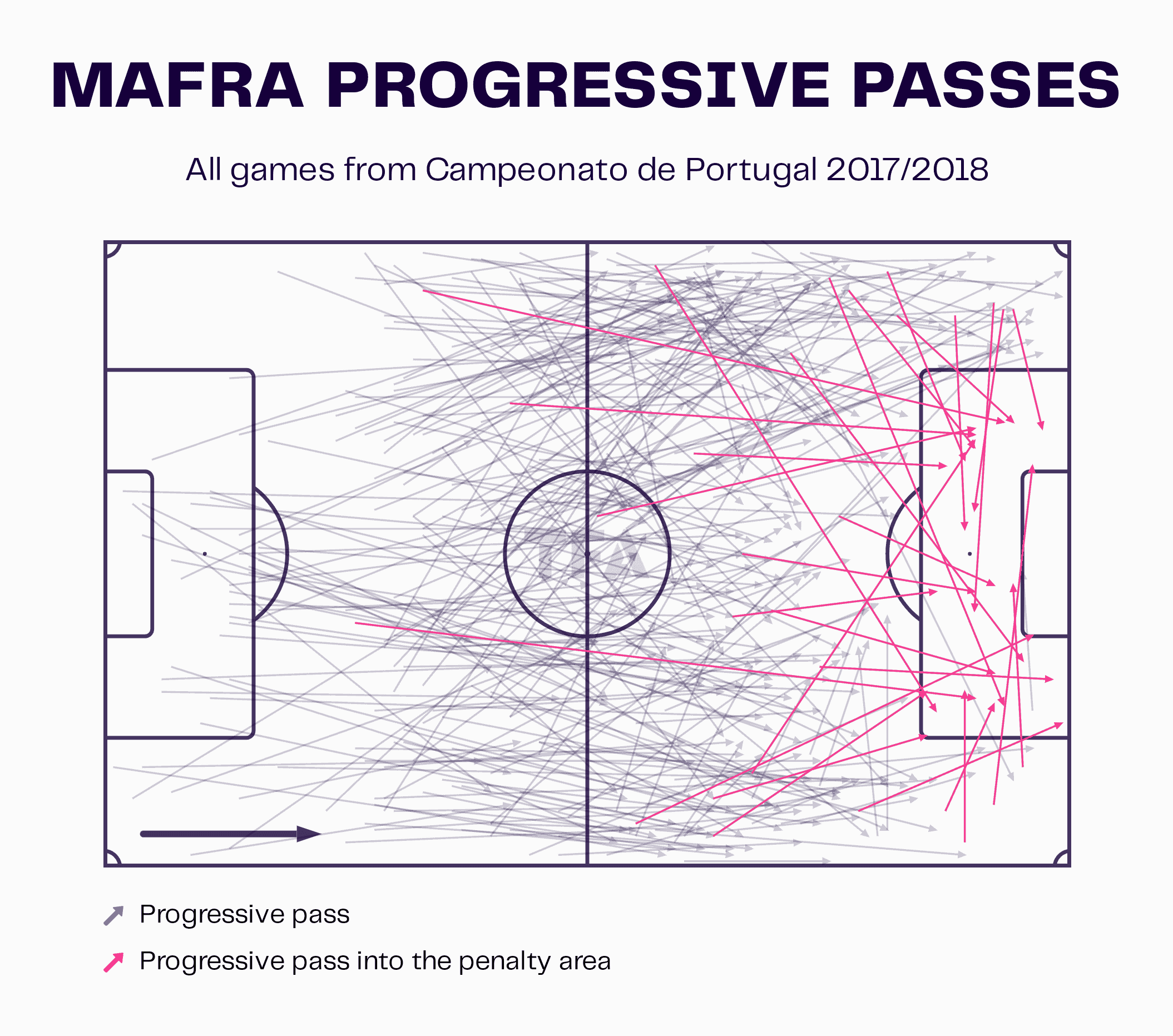
From the data visual above, we can see that Mafra did look to play the ball out wide quite often which is something that will become key to Freire’s tactics later on. Mafra didn’t particularly look to cross the ball often though. More often than not, they would look to work small intricate openings created via off-the-ball movement and intelligent choices.
Using the width of the pitch is something that we will see following Luís Freire throughout his managerial journey.
There are a few reasons why he has adopted this way of playing. For example, by using the wide areas, Freire’s team can stretch the opposition’s defence, creating more space for their attacking players to operate in. This can lead to increased goalscoring opportunities and put more pressure on the opposing team. Moreover, if the opposition is weak in defending the wide areas, a manager may want to utilise these areas to exploit their weaknesses and create scoring opportunities.
Sometimes, the opposition defence may be too compact in the centre of the pitch, making it difficult for a team to penetrate. By using the wide areas, a team can provide an alternative route to goal, creating more opportunities to score.
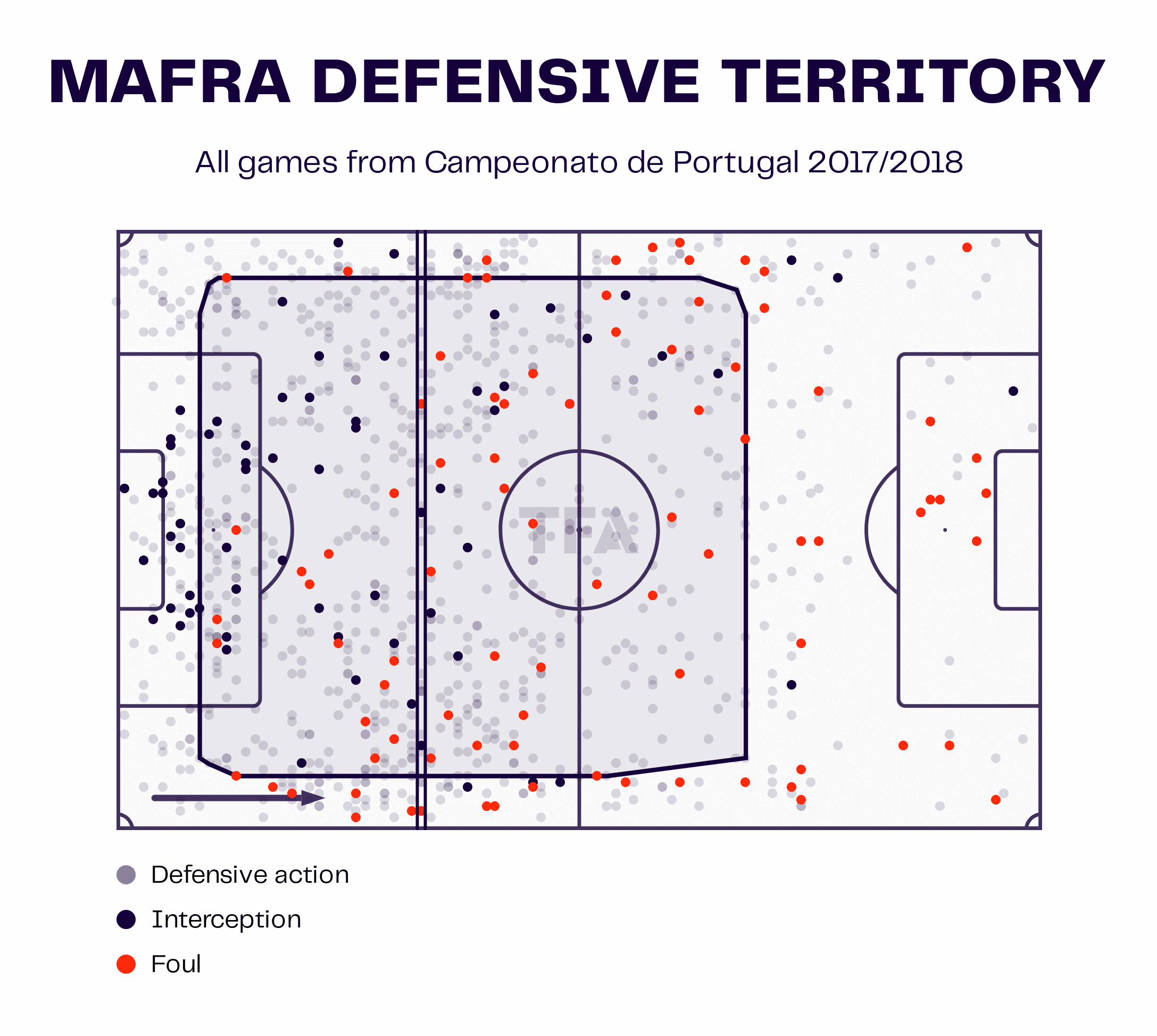
The data visual shows Mafra’s defensive territory during Freire’s tenure as manager. As we can see, he preferred his team to adopt a more cautious approach defensively. Mafra primarily opted for a low-block defensive setup which allowed them to look for opportunities to counterattack once they had regained possession.
Additionally, under Freire, Mafra averaged a PPDA of 9.41 per 90, on some occasions this number was as high as 15.21, indicating they were more than happy to cede possession to their opponents. His style of play was all about looking to counterattack quickly but effectively.
Throughout his time at Mafra, Luís Freire developed the basis for his managerial philosophy and tactics. As we move through this tactical analysis, we will take a more in-depth look at how his tactical style has evolved over time.
Nacional saviour and failure
Moving on, if we now take a look at Luís Freire’s time at Nacional, we can see how his tactical ideas have developed into a clear methodology and playing style. Throughout his tenure at Nacional, the young Portuguese manager largely favoured a 4-1-4-1 formation. Well, on paper it was a 4-1-4-1; in reality, the formation was much more fluid and showcased a great step forward in Freire’s tactical development as a manager.
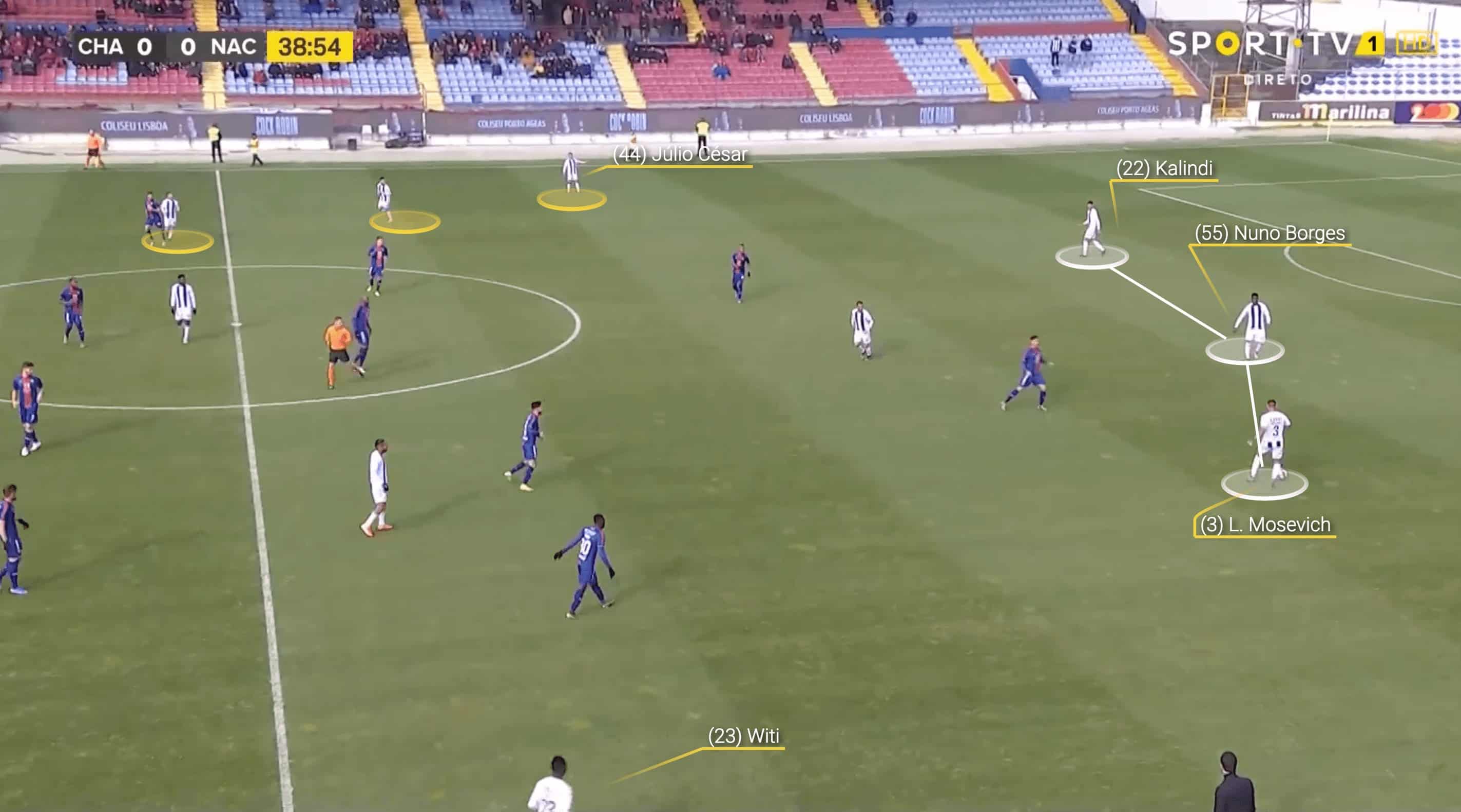
Here, for instance, we can see that the defensive midfielder Nuno Borges has dropped back to form a back three, alongside the two centre-backs. Meanwhile, the full-backs Julio Cesar and Witi have pushed higher up. Moreover, under Freire, Nacional looked to create overloads on the flanks when possible.
As shown in this image above, Nacional has three players over on the right flank which means they have a numerical advantage and therefore more attacking options available should they work the ball over to that side. Also, by attracting defenders to one side of the field, the Nacional team has the opportunity to create space on the opposite side for a player to receive the ball and make a run towards goal.
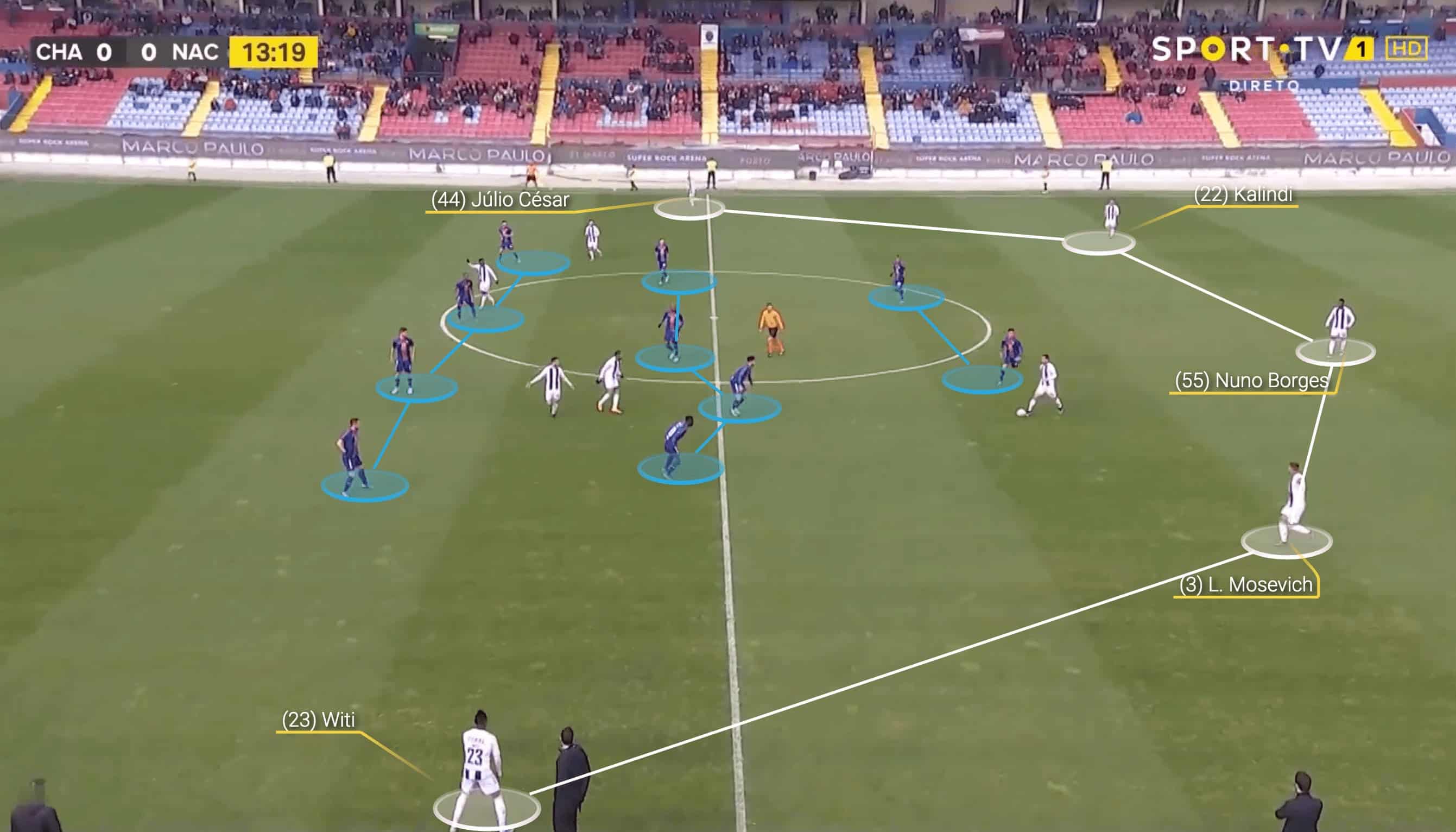
This is a perfect example of how a Freire team looks to stretch the pitch as wide as possible. As Nacional are looking to build up from the back, we can see the 4-1-4-1 formation has evolved into a three at the back with the full-backs becoming wing-backs.
With Witi and Julio Cesar staying as high and wide as possible, it means that the opposition is caught in two minds, they are unsure where to move out of their shape to press or to stay compact and look to prevent the central players from advancing the play.
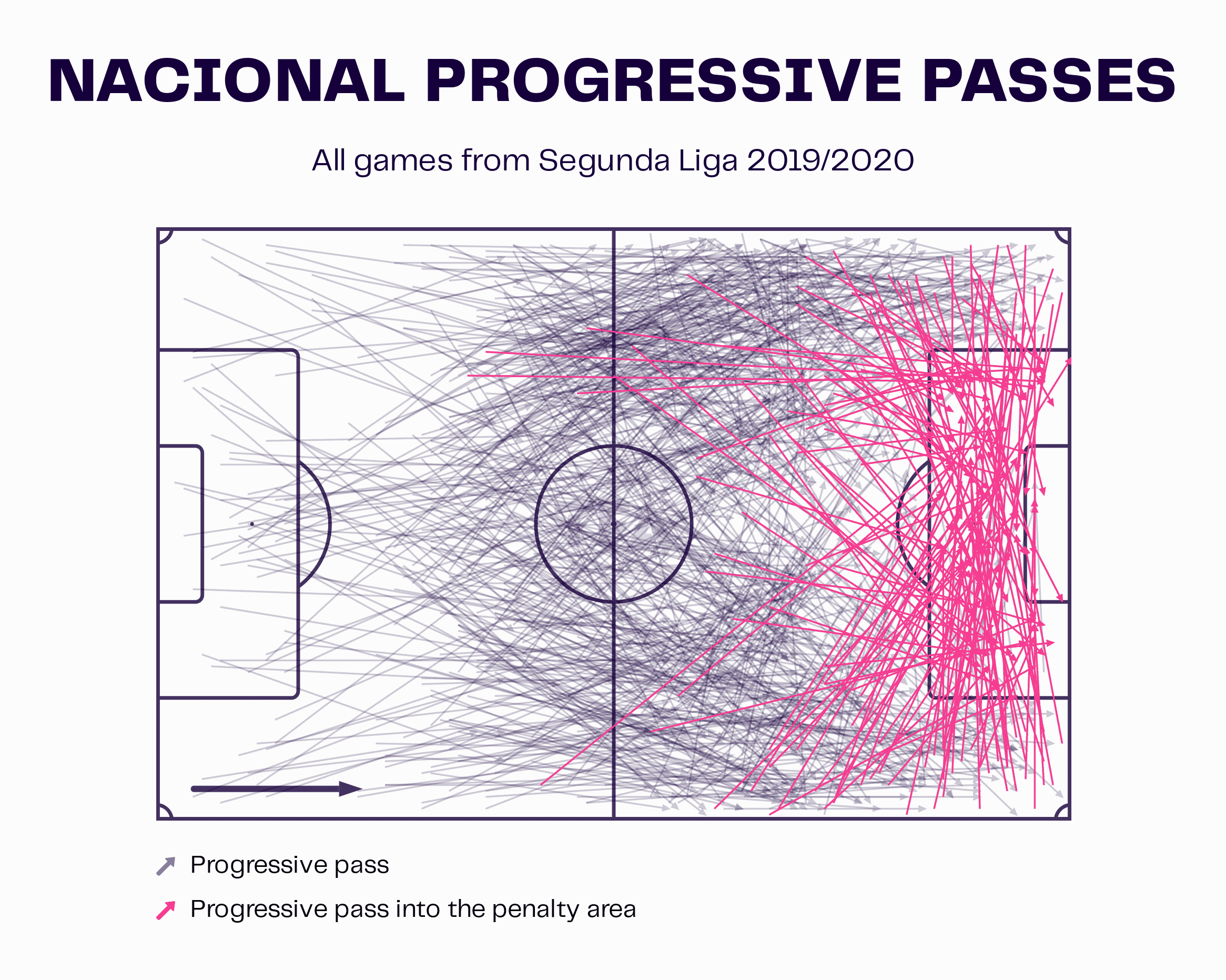
This data visual demonstrates Nacional’s progressive passes during Luís Freire’s time as manager. We can see that the style of play he was developing at Mafra, has come to fruition. Nacional looked to play progressive passes out wide, then the wide player would look to play the ball into the penalty area.
The Madeira-based side averaged 18.05 crosses per 90 during the 2019/20 season (before it was cancelled due to the pandemic). They also averaged 68.3 progressive passes per 90 which show that Freire demands his teams are proactive and use their possession wisely, Nacional constantly looked to be innovative when they had the ball at their feet.
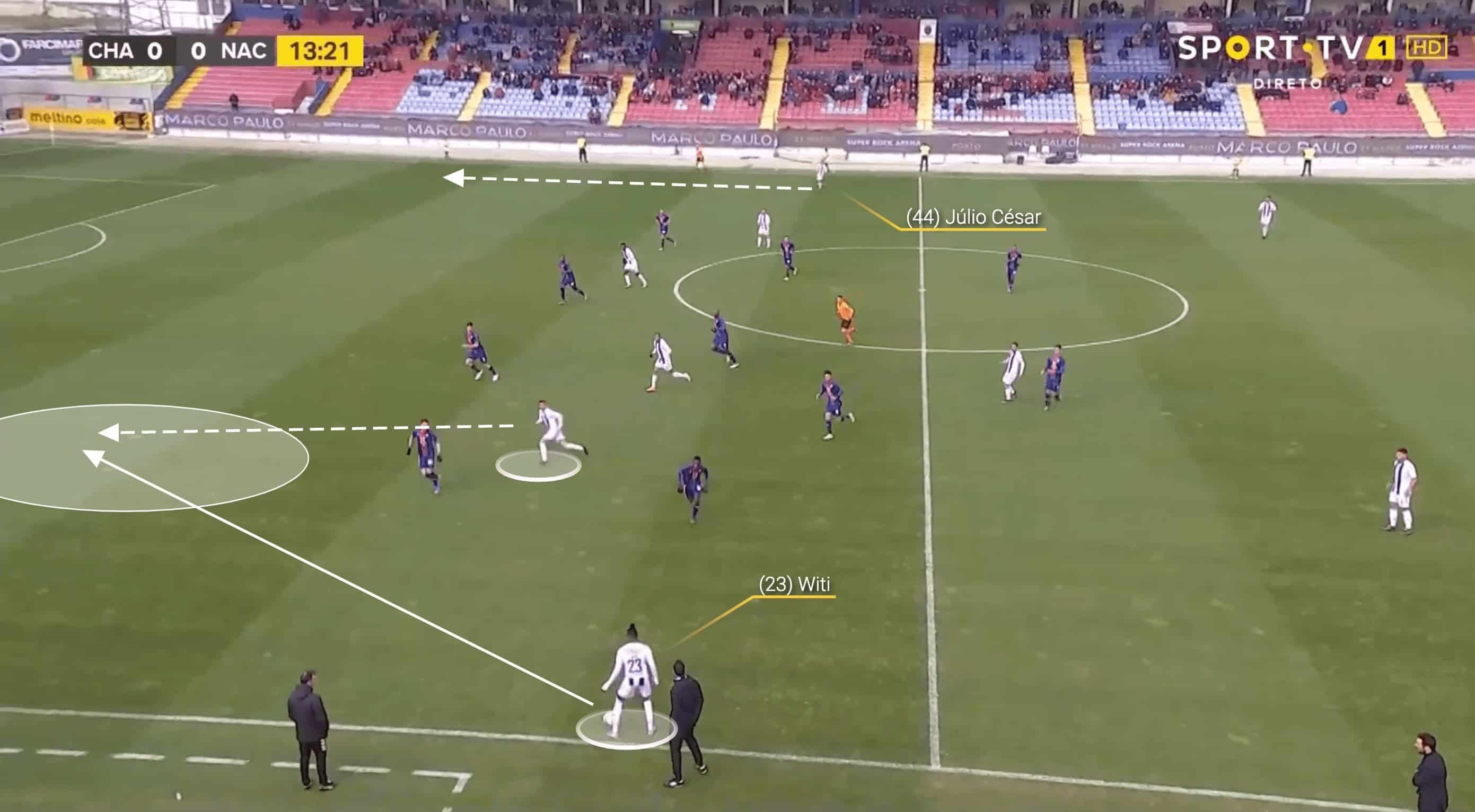
This example above demonstrates one way that Nacional would look to use the wide areas to their advantage. Julio Cesar and Witi are as wide as possible, virtually on the touchline, as the latter is in possession, we can see that the attackers begin making their runs forward. By staying wide, Witi has time and space to wait until the opportune moment to play a progressive pass forward which completely bypasses the defensive line.
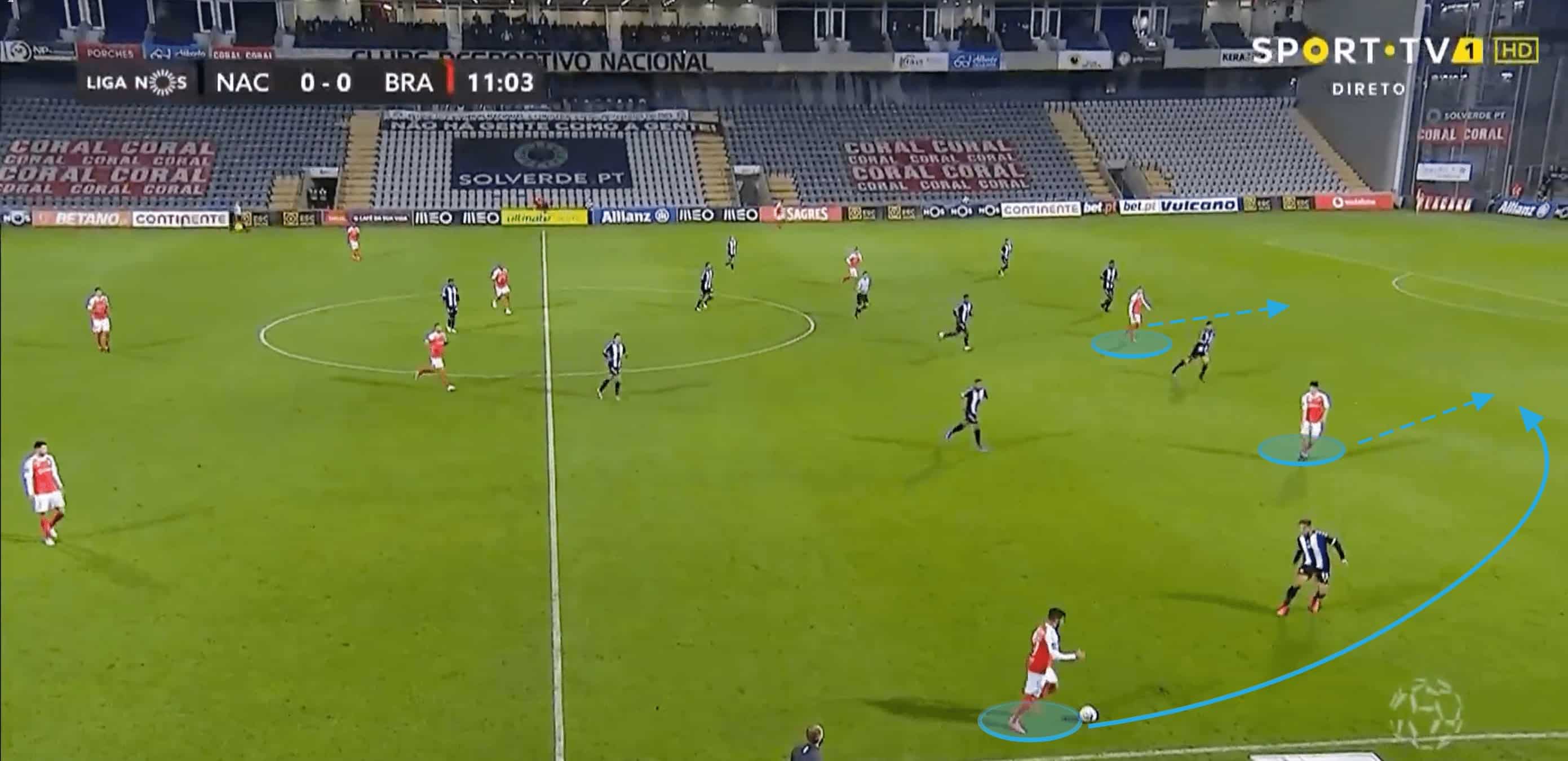
Whilst Freire’s tactics with Nacional saw them gain promotion, once in the Primeira Liga, they struggled to make an impact. Their performances were filled with naivety and it all became rather predictable. Teams with higher-quality players could easily play through Nacional, as seen in this example; there are so many gaps in their defensive structure that it is relatively easy for Braga to play a pass in behind the defensive line.
In the Segunda Liga, Freire’s team had been used to dominating possession, meaning they could essentially maintain control throughout the game. However, in the Primeira Liga, they struggled for possession and therefore they couldn’t execute Freire’s game plan. With no real ‘plan B’, Nacional endured a torrid time and Luís Freire eventually left his position as manager with the club just one point above the relegation zone.
Rio Ave redemption
In 2021, Rio Ave offered Freire a chance at redemption, an opportunity which he grabbed with both hands. Although Freire’s tactics have developed over the time he has spent with his previous clubs, it is during his time at Rio Ave that we have seen the young manager really come into his own and settle on a tactical philosophy.
Still utilising the wide areas
Since taking over at the club, the young Portuguese manager has favoured a 3-4-3 formation where he asks his team to utilise the width of the pitch as often as possible to either rapidly transition from defence to attack or look to construct a careful attack by creating the overloads we saw during his time at Nacional. Usage of the wide areas is by now a staple element of Luís Freire’s style of play. During his time at Rio Ave, he has developed this and honed in on how to make it successful without compromising the team in other areas.
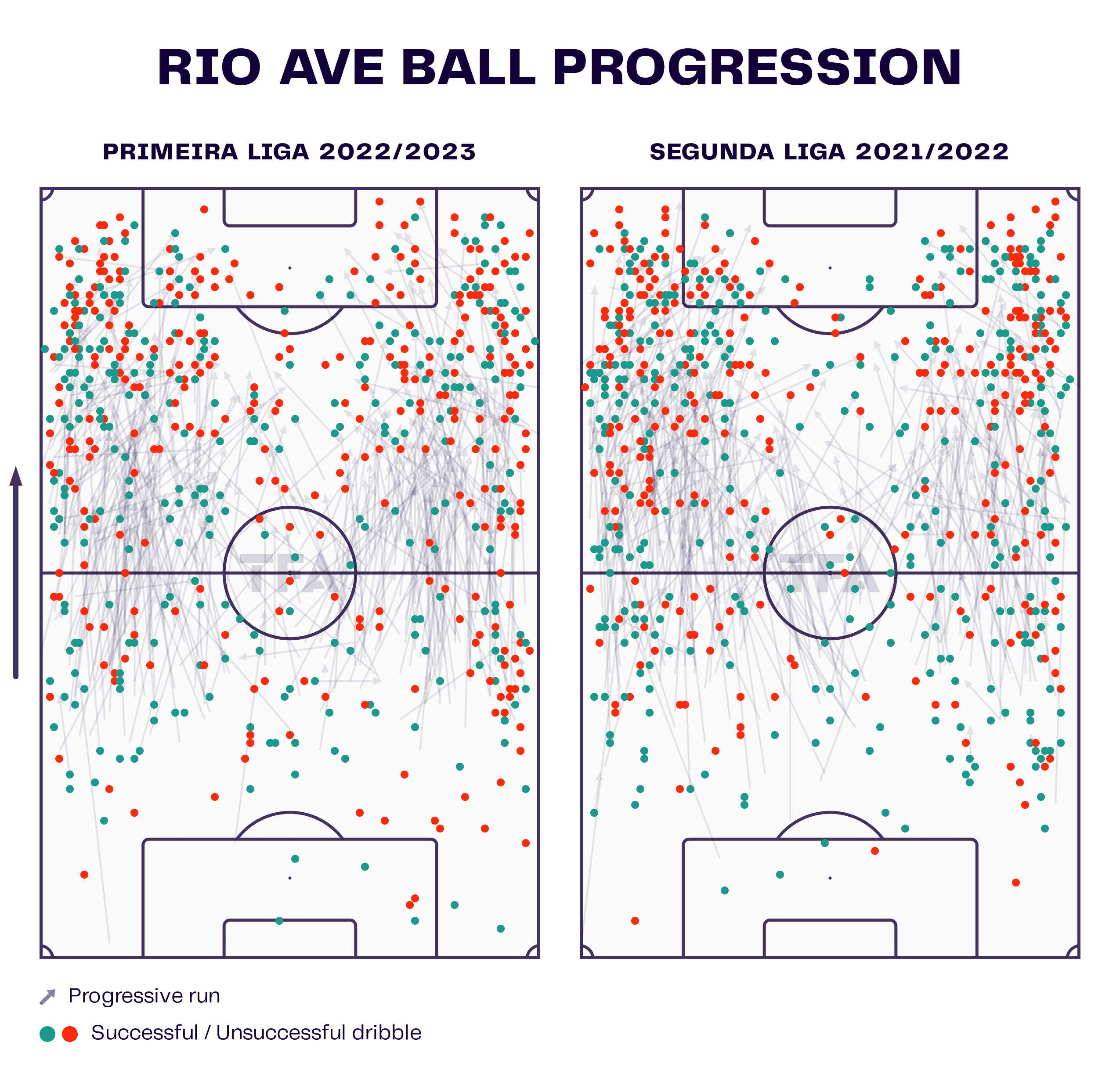
The data visual above clearly demonstrates just how often Rio Ave look to attack down the flanks, something that is a product of opting to play a 3-4-3 formation. The three forwards offer a lot of attacking options and allow for fluid dynamic movements from the players, making it harder for the opposition to defend against. Additionally, the four midfielders in this formation can help the team to retain possession of the ball and build attacks from the back.
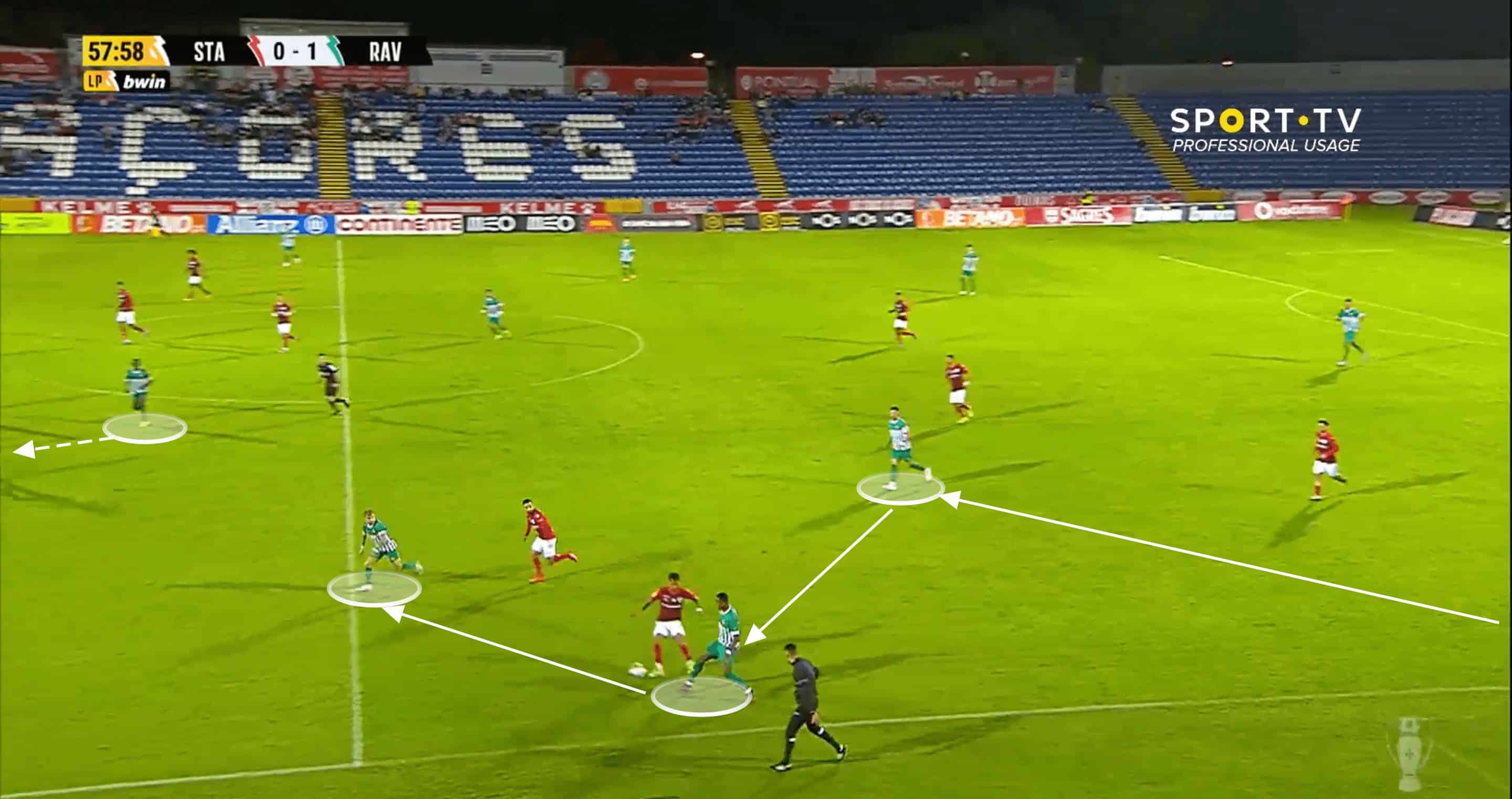
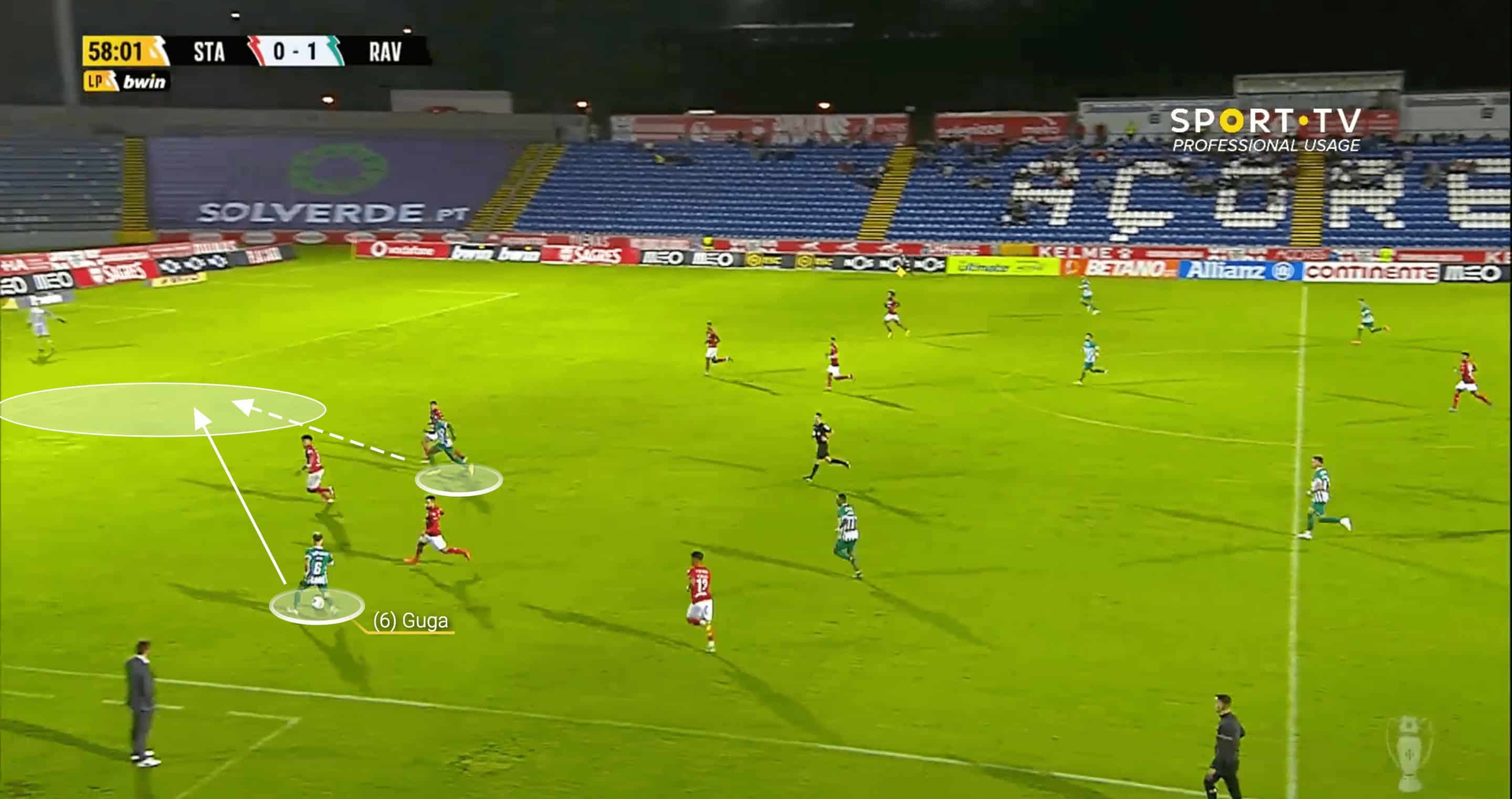
The images above show how Rio Ave looks to use a ‘zig-zag’ style of passing in order to work the ball up the pitch. By working the ball from out wide, into the halfspace and then out wide once again, the opposition players can be drawn out of position as they attempt to prevent the attack.
The swift movement of the attacking players coupled with the width allows Rio Ave to play around their opponent’s defensive structures comfortably. In this example, we can see how Rio Ave have worked the ball up the flank by utilising the halfspace and the wide area. Guga is then presented with the opportunity to play the ball behind the defensive line as Emmanuel Boateng makes a forward run.
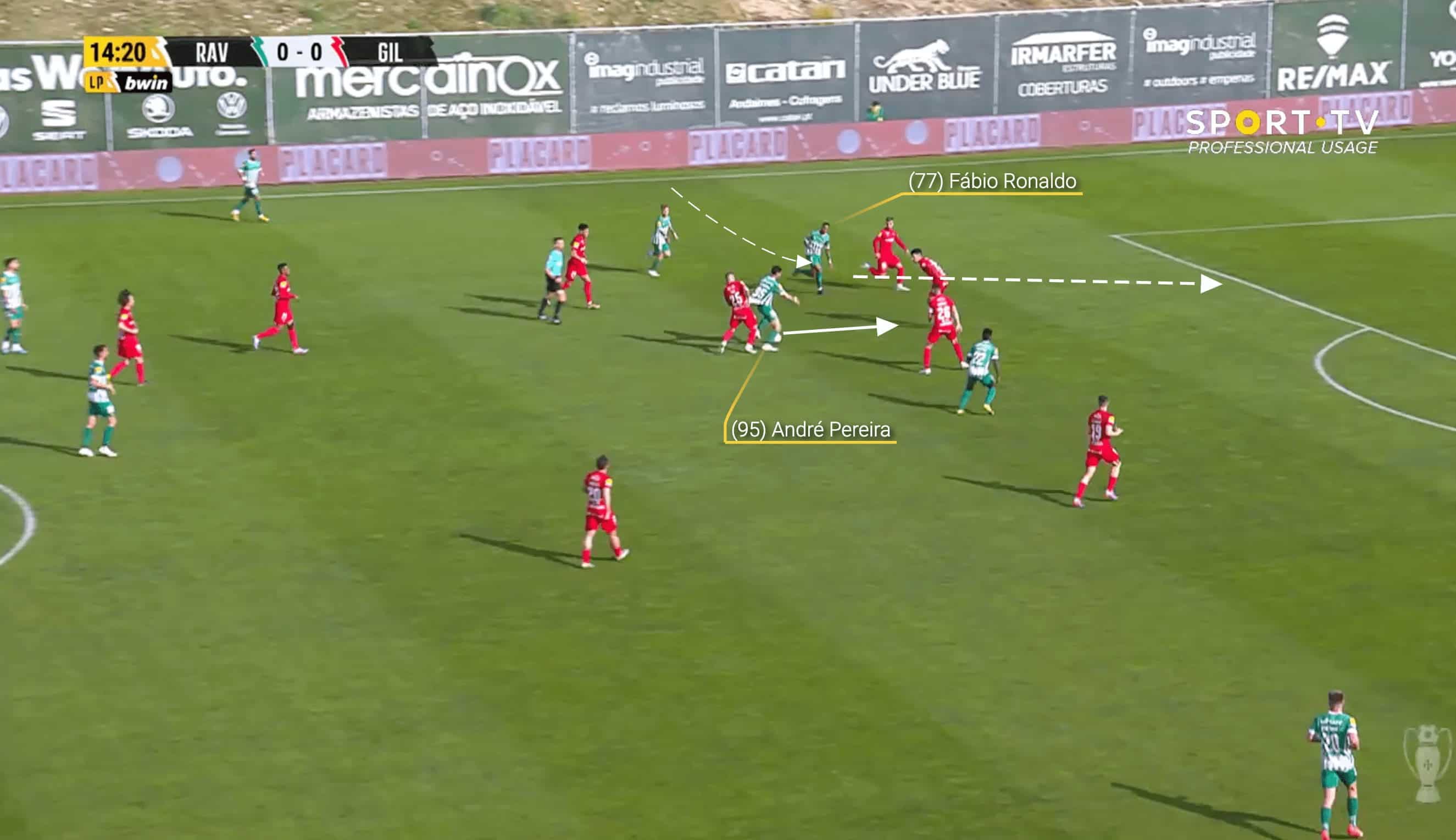
Here, we can see another example of why the wide areas are so important to Freire’s tactics. Fábio Ronaldo makes an arching run from the left wing which enables him to break through the lines. André Pereira is able to hold off the opposition defenders surrounding him and play a well-placed pass down the line and into the path of Fábio Ronaldo who is through 1v1 with the goalkeeper and able to score a powerful shot into the top corner.
This is something that Freire has added to his tactical methodology during his tie at Rio Ave. The 3-4-3 formation really allows the wide midfielders/wing backs, usually Fábio Ronaldo and Costinha to be the focal points of the attack as they make arching runs into the penalty area which causes chaos for the opposition who already have to deal with the three forwards.
Centre backs as an attacking outlet
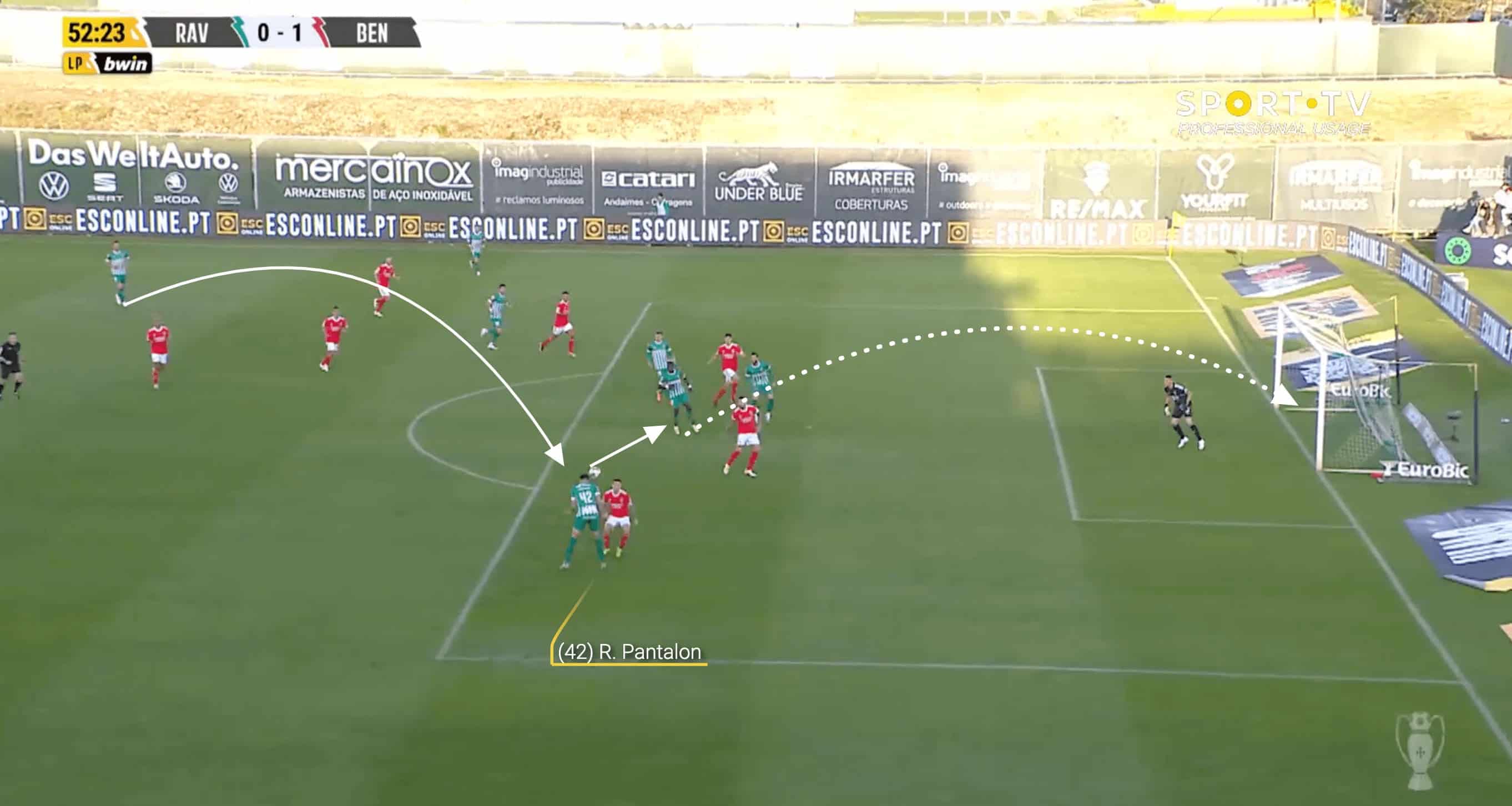
A newer element of Luís Freire’s style is the usage of ‘wide centre-backs’. This is something that has become a vital part of Rio Ave’s play under Freire’s leadership, it’s certainly the option they turn to the most when they are a goal down and looking to get back into a game. This example above, shows how Renato Pantalon has joined the attack as Rio Ave looks for an equaliser.
As a centre-back, Pantalon is tall and physically strong, which gives Rio Ave an advantage in aerial duels, as shown in this example, he can comfortably win the ball in the air. Additionally, by Pantalon pushing forward, the Benfica defence is forced to shift and adjust, creating spaces for other attacking players to exploit.
We can clearly see that Rio Ave have a numerical advantage with four attacking players in the penalty area compared to three defenders. In this instance, Pantalon heads the ball onto Boateng who is able to get a shot on target. This goalscoring opportunity was generated entirely out of Renato Pantalon joining the Rio Ave attack.
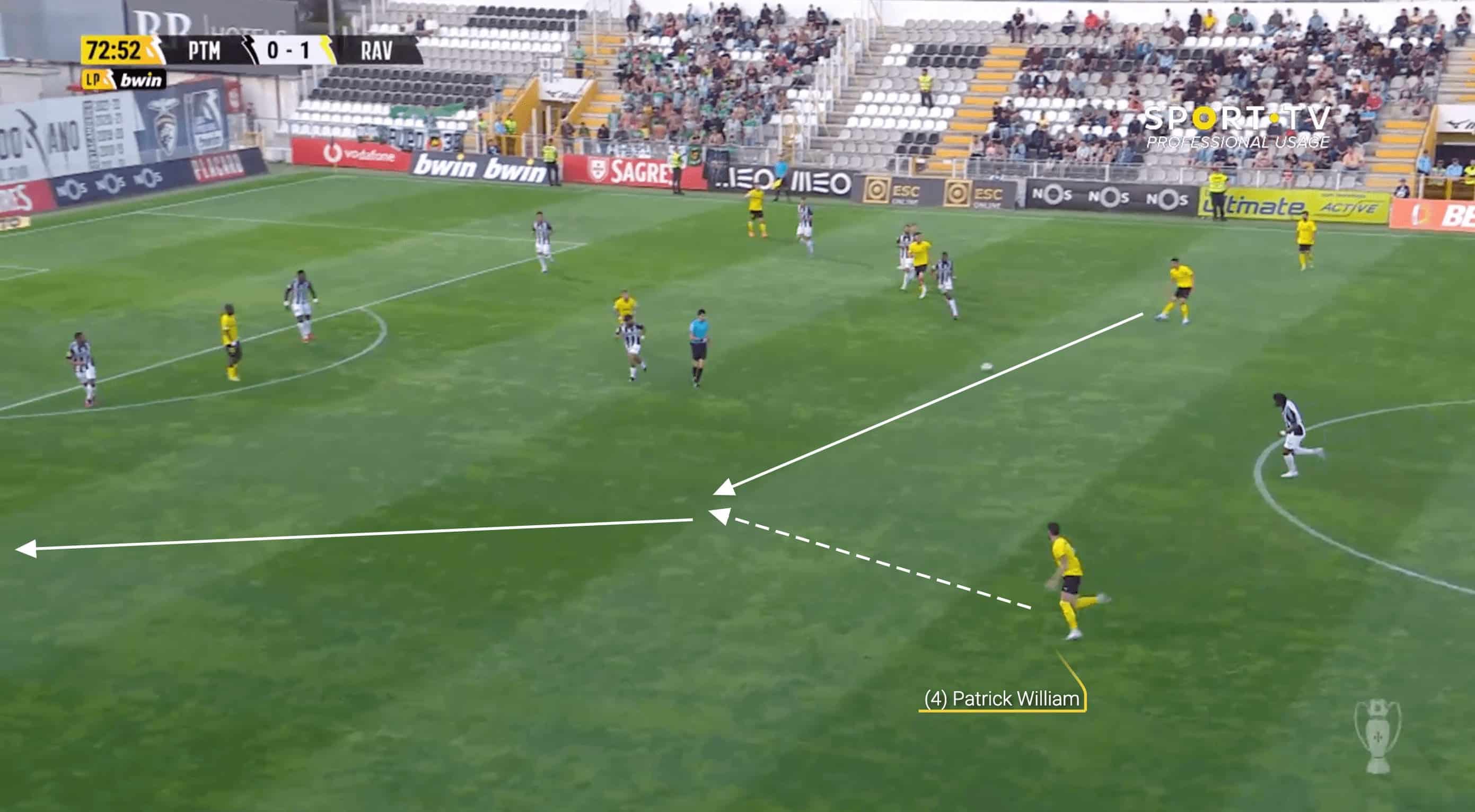
This is another example of wide centre-backs being involved in Rio Ave’s very aesthetically pleasing style. Left-sided centre-back Patrick William can be seen making a run forward to join the attack as Rio Ave’s positioning means that the opponents are virtually pinned into their current shape. He charges forward and as he receives the ball, he immediately sweeps it out wide to Fábio Ronaldo who is virtually out on the touchline.
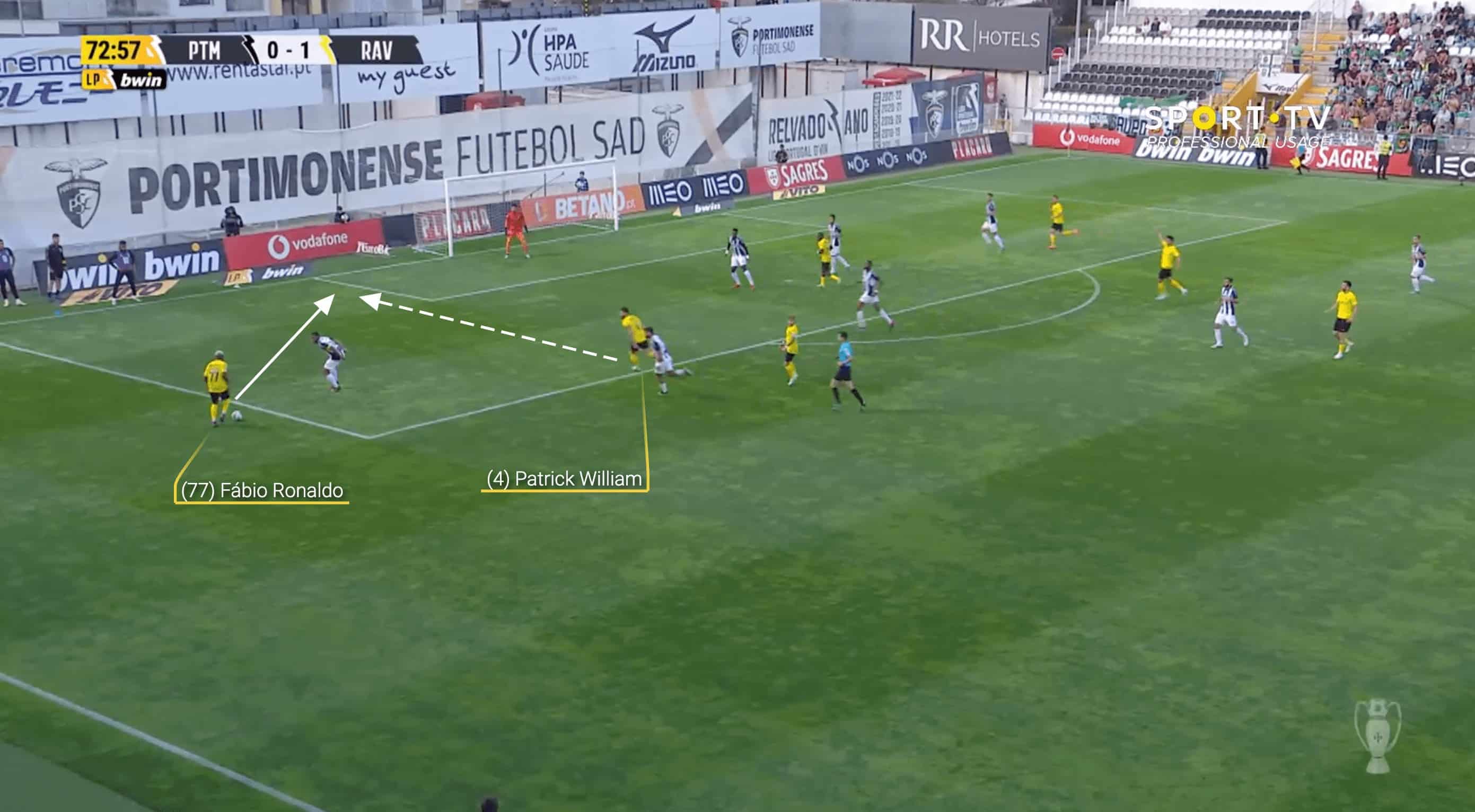
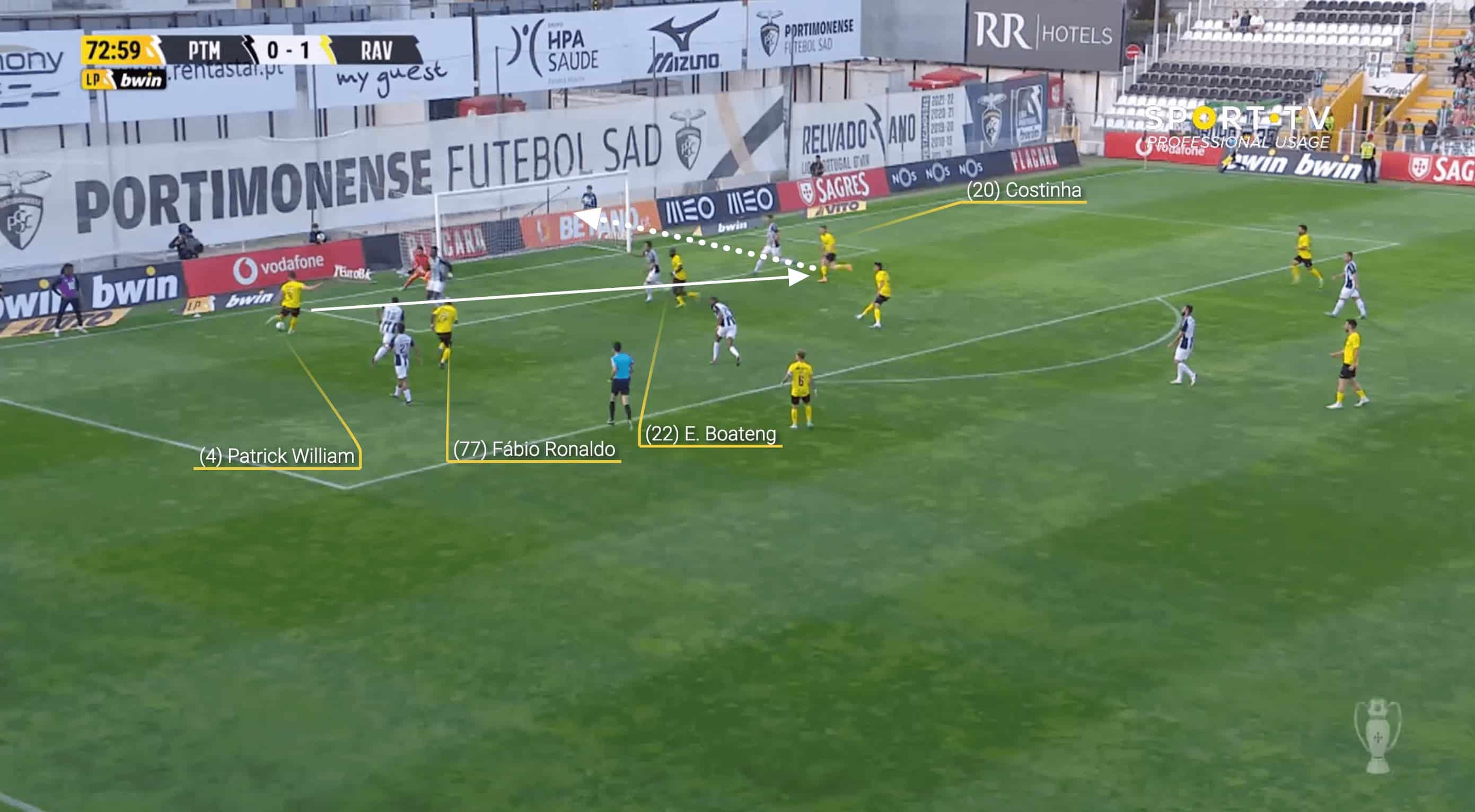
As we can see here, in a move that is somewhat similar to what we would see from Sheffield United under Chris Wilder; Ronaldo looks to dribble the ball into the penalty area. At the same time, Patrick William has continued his run forward. Ronaldo plays an intricate pass into the path of the Rio Ave centre back who then plays a sweeping ball across the face of goal where the right-sided midfielder/wing-back Costinha is waiting to turn the ball into the back of the net.
Wide centre-backs provide additional options for overlapping and underlapping runs during the attacking phase. This creates space for the attacking midfielders, wide players and forwards to operate in and stretch the opposition’s defence. This also provides Freire’s team with more flexibility in terms of their tactical approach — for example, as we have seen, the wide centre-backs can help to overload the opposition’s defensive flanks, or they can drop back to provide additional defensive cover when needed.
Smart set pieces
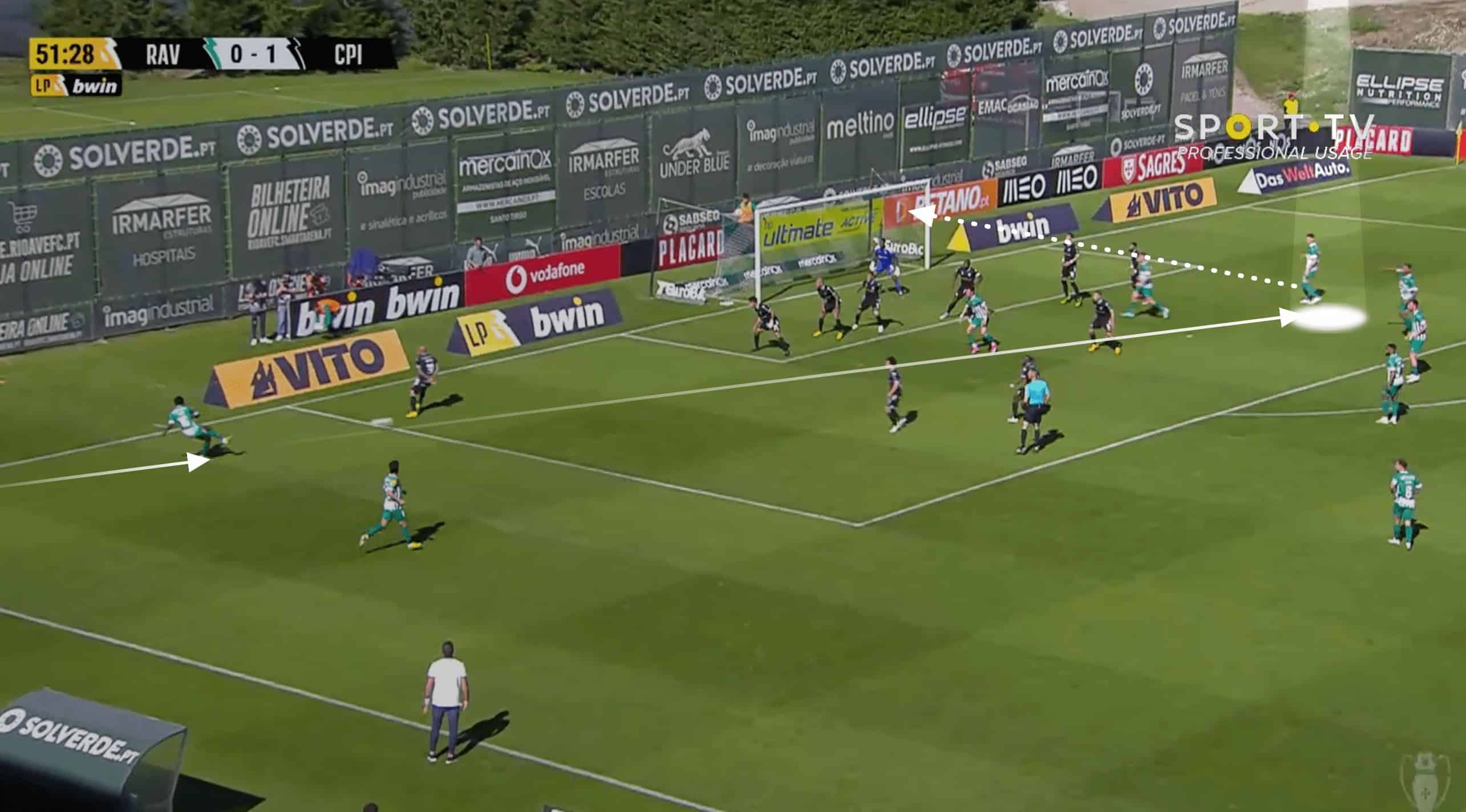
Freire also understands that in order for his team to pick up valuable points, they need to have a variety of ways by which to ensure they notch up the wins. Making the most of set pieces has become an incredibly useful tool in the Rio Ave arsenal as they look to maintain their top-flight status this season. By having a variety of set-piece routines, Rio Ave can keep their opponents guessing about what they will do during a set piece.
This can make it harder for the opposition to set up their defence and can create more opportunities for them to take advantage of. Additionally, the three centre-backs mean that there are three physically strong and tall players who are all capable of winning aerial duels which in turn gives Rio Ave an advantage during attacking set pieces.
In this example seen above, Rio Ave plays a short corner whilst the Casa Pia defence is set up in its zonal system to defend set pieces. Freire’s side uses this to their advantage as they play a low cross across the penalty area where they have three players waiting to turn the ball goalwards. Rio Ave have become adept at using set pieces in an effective way to score goals, this adds another dimension to a team’s attacking play under Luís Freire.
Effective low-block defending
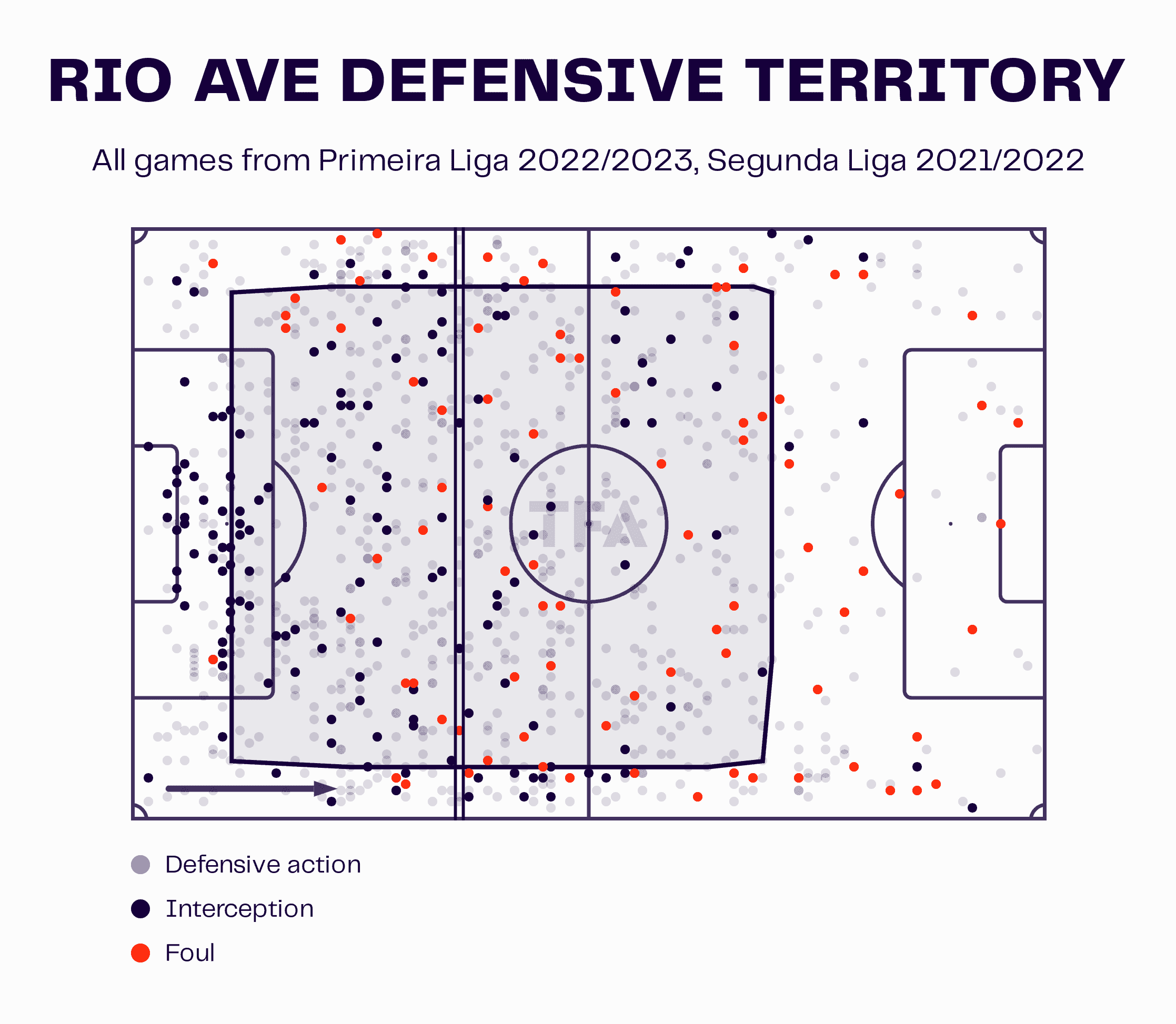
As the visual shows us, under Freire, Rio Ave’s defensive territory is not indicative of a team that likes to consistently press high. In fact, their low-block defending has become a key element of Rio Ave’s play in the defensive phase.
This can be effective against teams with a lot of attacking talent. By defending deep, the team can limit the amount of space that their opponents have to work with, making it harder for them to create scoring opportunities.
Furthermore, low-block defending can be particularly useful when facing an opponent that likes to play with a lot of possession. By dropping deep and defending in numbers, the Rio Ave team can frustrate their opponents and force them to take shots from distance or play ineffective passes.
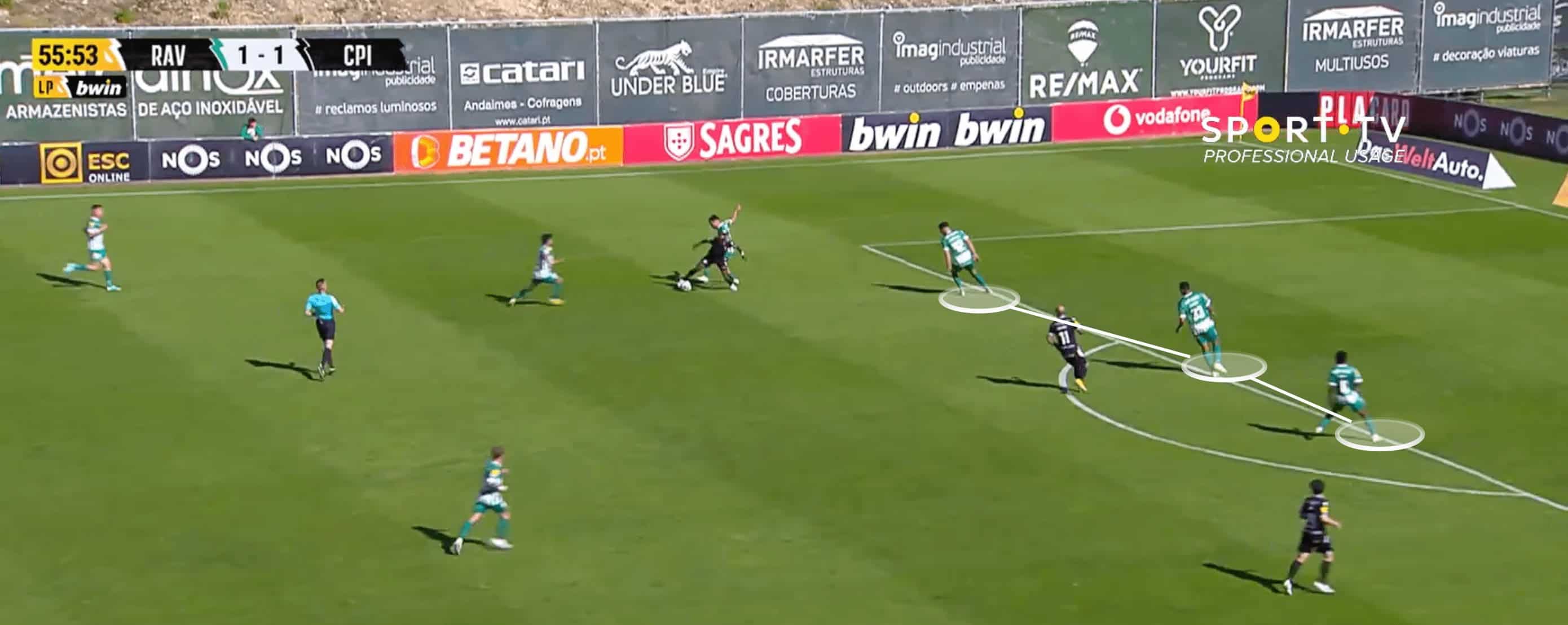
In this example, we can see that Rio Ave has fallen back into a low block as the three centre-backs look to stay in their defensive line. It is primarily left to the wing-backs/ wide midfielders and the central midfielders to attempt to regain possession. The role of the central defenders is to remain as compact as possible and ensure they are on hand to prevent the ball from reaching the attackers in the penalty area.
Additionally, it provides Rio Ave with an opportunity to use their speed on the counterattack, by packing their own half with defenders, which makes it difficult for their opponents to score. Therefore when Freire’s side does win possession, they can utilise their wide players who possess great acceleration and can quickly launch a counterattack. This is especially effective against teams that push a lot of players forward in attack and leave themselves vulnerable at the back.
In essence, low-block defending allows Rio Ave to absorb pressure and then hit their opponents on the break as soon as they win the ball back. This is a very effective way to score goals, especially as the team has fast and skilful players who can quickly transition from defence to attack.

Freire’s 3-4-3 formation is not a rigid structure, especially in defence and build-up play. Here we can see that Rio Ave are looking to build from the back after recovering possession. We can see their defensive structure here; there are the three centre-backs that as we know, mostly remain a compact block.
The wide midfielders will act as wing-backs in the defensive phase. Additionally, to match the opposition’s three-man midfield, Fabio Ronaldo, who is one of the front three attackers, has dropped back to form a three-man midfield to match. This allows Rio Ave to play with a defensive midfielder who acts as a shield to the three defenders. It is this defensive setup that has helped Rio Ave to gain promotion last season and to perform above expectations so far this season.
Conclusion
Luís Freire has worked his way up in the managerial world and has evolved his tactical methodology during his time at each club. His desire to play an aesthetically pleasing and progressive style of football has been evident throughout his journey as a manager.
Freire has rightly gained plenty of plaudits for the job he has done at Rio Ave and as a result, his name has been mentioned as a possible replacement for Rúben Amorim when he inevitably departs from Sporting.
Whilst early on, it may have looked like Freire was simply a promotion specialist who couldn’t cut it at the top; the current campaign with Rio Ave has shown that he has developed as a manager and has what it takes to manage in the Primeira Liga. Making the step up to a club such as Sporting is the next natural progression for this very talented manager who looks set to become one of Portugal’s finest.

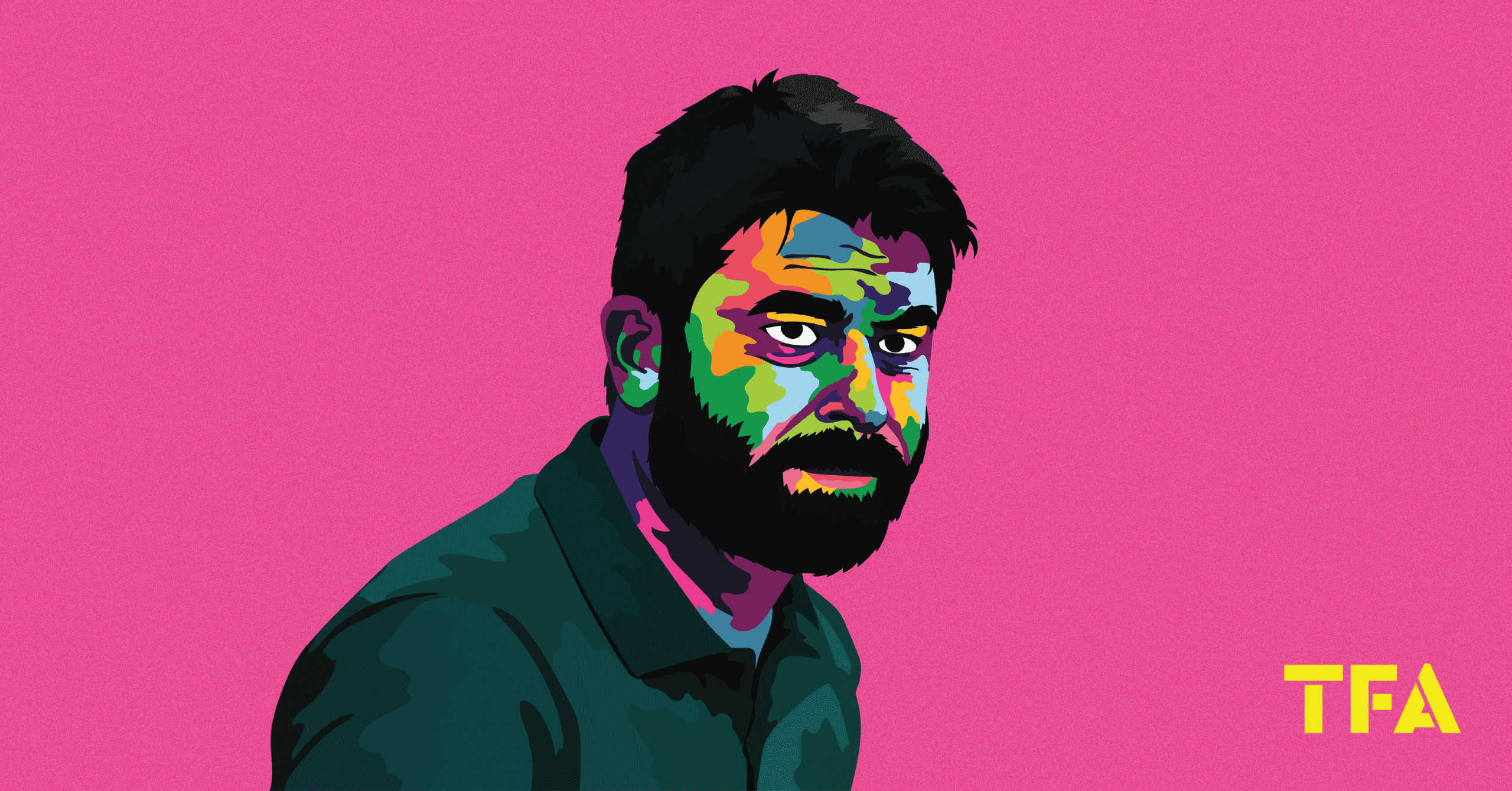



Comments